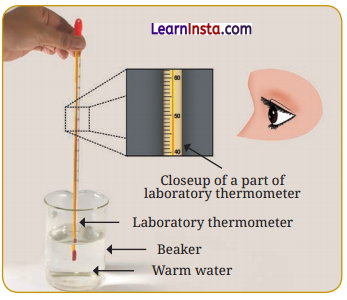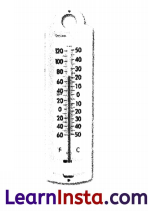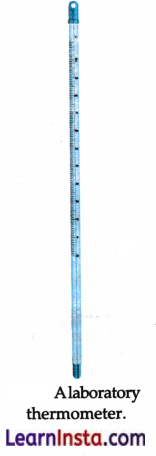Class 6 Science Chapter 7 Notes Temperature and its Measurement
→ Hot: When something is hot, it means it has a high temperature. For example, hot tea can burn if you touch it.
→ Cold: This refers to something that has a low temperature. Ice cream is cold and feels cool to touch.
→ Temperature: A reliable measure of hotness or coldness of a body is its temperature.
→ Thermometer: A device that measures temperature is called a thermometer. There are two kinds of thermometers – clinical thermometers and laboratory thermometers.
Measuring Temperature:
1. Clinical thermometer:
→ A device used for measuring the body temperature of a human or other animal. These are also known as digital clinical thermometers and run on batteries.
→ These measure temperatures when the thermometer is placed in contact with a person’s body.
→ Clinical thermometers generally use a scale called the Celsius scale. On this scale, the unit of temperature is degree Celsius and is denoted by °C.
→ For children or elderly individuals, a digital clinical thermometer can be placed in the armpit to measure body temperature. The reading is typically 0.5°C to 1°C lower than the true body temperature.
→ Infrared thermometers: They are non contact thermometers, that can measure temperature without touching a person’s body and the normal temperature of a healthy human body is taken to be 37.0° C.
→ Mercury thermometer: A device used to measure temperature using mercury, which expands on heating and contracts on cooling but mercury is an extremely toxic element and is difficult to dispose of if the thermometer breaks accidently. So, digital alternatives are becoming more popular because they are safer than mercury thermometers.
![]()
Scale of Temperature:
- Celsius Scale (°C): In Celsius scale, the freezing point of water is 0°C, boiling point is 100°C.
- Fahrenheit scale (°F): In Fahrenheit scale, the freezing point of water is 32°F, boiling point is 212°F.
- Kelvin scale (K): Temperature in Kelvin scale = Temperature in Celsius scale + 273.15.
2. Laboratory thermometer:
→ The instrument that is used to measure the temperature for scientific research in schools and labs.
→ It consists of a long, narrow and uniform glass tube which is sealed. At one end of the tube, a narrow column of liquid can be seen. There is a Celsius scale marked along the tube.
→ The liquid column rises or falls with change in temperature. The mark of Celsius scale with which the top level of the liquid column coincides is the temperature reading.
→ The liquid used in this thermometer is generally alcohol or mercury.
→ Correct way of measuring temperature using a laboratory thermometer:

→ When the thermometer is immersed in water, its bulb should not touch the bottom or the sides of the beaker.
→ Thermometer should be held vertically.
→ Temperature must be read while the thermometer is immersed in water.
→ While reading the thermometer the eye should be straight in line with the level of the water column.
![]()
Air Temperature:
→ Air temperature or room temperature refers to the measurement of how warm or cool the air is in a particular space, such as a room, outdoors, or inside a building. It is typically measured using a thermometer designed to record temperatures in degrees Celsius (°C) or Fahrenheit (°F). Whereas air temperature tells us how hot or cold the air is around us and room temperature refer to the temperature inside a room or building.

→ Air temperature : It is the maximum and minimum temperature at a place.
→ Analysis : To-examine something by examining its parts and their relationship.
→ Celsius Scale : In celsius, the lower fixed point is 0°C and the upper fixed point is 100°C. The interval between the two found points is divided into 100 divisions.
→ Calenlate : To compute.
→ Clinical thermometer: The thermometer used for measuring the temperature of human body is called clinical thermometer.
→ Compare : To be like or equal.
→ Degree Celsius : On celcius scale, the unit of temperature is degree celsius.
→ Discuss : Talk and exchange opinion.
![]()
→ Degree Fahrenheit : On Fahrenheit scale, the unit of temperature is degree Fahrenheit.
→ Investigate : To inequire.
→ Kelvin : On Kelvin scale, the unit for temperature is Kelvin and is denoted by k. The S.I. unit of temperature is kelvin.
→ Observe : To see or notice.
→ Laboratory thermometer : A thermometer used for measuring the temperature in a science laboratory is called laboratory thermometer.
→ Precaution : Thing done in advance to avoid danger.
→ S.I. unit of temperature : The S.I. unit of temperature is kelvin. It is denoted by k.
→ Predict : forecase.
→ Temperature : The temperature of an object is the degree of hotness or coldness of the object.
→ Record : To write down facts and events.
→ The temperature of a body tells us how hot or cold it is.
![]()
→ The three most-used scales of temperature are: (a) the celsius scale, the Fahrenheit scale and (b) the kelvin scale. The units of temperature in these scales are (a) degree celsius, denoted by °C, (b) degree Fahrenheit, denoted by °F and (c) kelvin denoted by K.
→ The S.I. unit for temperature is kelvin.
→ A clinical thermometer is used for measuring body temperature.
→ Normal temperature of a healthy human adult is taken to be 37.0°C or 98.6°F.
→ Laboratory thermometers typically have a temperature range from -10°C to 110°C.
Introduction
The normal temperature of a human body is 37°C . Actually, it is the average body temperature of a large number of healthy persons. So, the normal body temperature of every healthy person may not be exactly 37°C . It could be slightly higher or slightly lower than 37°C . So a person should not worry even if his body temperature is slightly higher or lower than the standard body temperature of 37°C .
Sometimes we may have a feeling of feverish, when we just touch our forehead. We feel that we might be having a fever. But this is not always true. It can not always correctly judged, that a person has fever, only by touching the forehead of the person.
![]()
Hot Or Cold
We know that some objects are hotter than others, while some are colder than others. We often decide which object is hotter than the other by touching the object.
Temperature
A reliable measure of hotness or coldness of a body is its temperature. The temperature of an object is the degree of hotness or coldness of the object. A device that measures temperature is called a thermometer. There are two kinds of thermometers-Clinical thermometers are used to measure human body temperatures whereas laboratory thermometers are used for measuring the temperature in a science laboratory.
Measuring Temperature
Clinimal Thermometer: This type of thermometer is used for measuring our body temperature. Such thermometers show temperatures digitally. These are also known as digital clinical thermometers and run on batteries. These measure temperature when the thermometer is placed in contact with a person’s body. Temperature in a digital termometer is determined with the help of heat sensors.

For measuring temperature, the clinical thermometer generally use a scale called the celsius scale. On this scale, the unit of temperature is degree celsius and is denoted by °C.
Earlier mercury thermometers were used for measuring the body temperature. But mercury is an extremely toxic substance and is difficult to dispose of if the thermometer breaks accidently. The clinical thermometer has a range from 35°C (lower fixed point) to 42°C. (Upper fixed point) because temperature of a human body never goes beyond these limits. The normal temperature of a human body is 37°C or 98.6°F.
Infrared Thermometer:
During the COVID-19 pandemic, some special thermometers were used, which could measure the temperature of a person from a distance. These thermometers are non-contact thermometers. They are also called infrared thermometers. Such thermometers can measure temperature without touching a person’s body. Thus, reduce the risk of spreading disease.

Relationship between Celsius and Fahrenheit Scale :
A relationship that is used to convert temperature in celsius scale to Fahrenheit scale or vice versa is
Here \(\frac{C}{100}=\frac{F-32}{100} \text { or } \frac{C}{5}=\frac{F-32}{9}\)
Here C = temperature in celsius scale.
F = temperature in Fahrenheit scale.
![]()
In scientific work, there is another scale of temperature known as Kelvin scale. On this scale, the unit for temperature is kelvin and is denoted by k. The S.I. unit of temperature is Kelvin.
→ Laboratory Thermometer: A laboratory thermometer is used in laboratories for measuring temperature while performing experiments.
It consists of very five capillary tube, protected by a thick glass take called the stem of the thermometer. The lower end of the capillary tube is converted into a glass bulb filled with mercury. The upper end of this tube is sealed. The stem is marked °C or °F.

The commonly used laboratory thermometers have a range from -10°C to 110°C. The upper fixed point is 110°C. The lower fixed point is -10°C. The smallest division can read 1°C. That is the smallest value that this thermometer can read is 1°C. Correct way of measuring temperature using a laboratory thermometer.
- When the thermometer is immersed in water, its bulb should not touch the bottom or the sides of the beaker.
- The thermometer should be held vertically.
- The temperature must be read while the thermometer is immersed in water.
- While reading the thermometer, the eye should be directly in line with the level of the liquid column to be read.
![]()
→ Air temperature: Room thermometers can be seen on the wall of the school laboratory. These thermometers give an approximate idea of the room temperature. Weather reports in newspapers, T.V. news or internet, also mention the maximum and minimum air temperature of the day.
→ Anna Mani (1918-2001) was an Indian scientist. She is also known as weather women of India. She invented and built a large number of weather meas u rement instruts. This reduced the reliance of India on other nations for such instruments. She explored the possibilities of using wind and solar energy in India. Her work helped India to becomes one of the global leaders in renewable energy.
